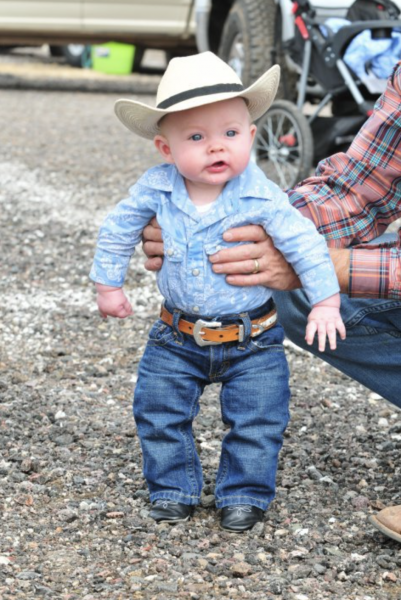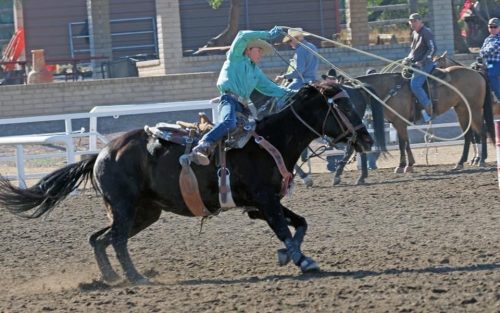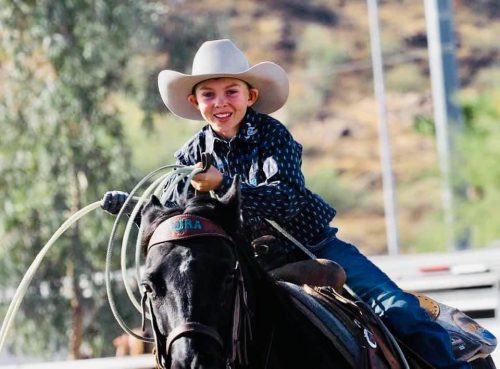By Mackenzie Payton / El Inde
It’s 6:30 a.m. in the little town of Cave Creek, Arizona, and unlike most preteens his age– Stockton Caswell is ready for chores. Many understand a child’s chores as doing the dishes, taking out the trash, or maybe feeding the family dogs. While feeding Sketch and Gracy, two corgis and a feisty little pug named Bexley is his responsibility — Stockton must also serve breakfast to eight goats, nine horses, and a herd of steers.
He tries to escape his duties, “Mom… Can’t Steele and Sutter Jo come to help me today?” But he knows the truth, that his 7-year-old rowdy little brother and 4-year-old sister will not be leaving their beds anytime soon. Allie, his older sister, works as a full-time night shift nurse, leaving the 11-year-old in charge. Truthfully, Stockton does not mind taking care of the farm animals; he enjoys the work, but he is also a child coming to terms with being one of the oldest siblings and gaining more responsibility.
He pulls on his Wrangler blue jeans, denim shirt and adds a white straw cowboy hat without waking up the others. He completes the outfit with a denim jacket and cowboy boots to take on the day’s challenges. Even in southern Arizona, the morning air still chills his young face as he steps into his 1-acre backyard. Someone would compare his everyday look to a young John Wayne, but Stockton would not want to be caught in anything else. As a fourth-generation cowboy, he plans on playing this character for life.

I can’t help but admire a child dedicated to his passion and willingness to work for it at such a young age. It took me many years of exploring new areas of study, travelling to different parts of the world and meeting dozens of people to discover my path in life. And, at 21 years old, I would say I’m still figuring out which turns to take. However, Stockton is different: this boy, although juvenile, has his future mapped out, unlike most.
Stockton will inevitably face bumps in the road; however, after watching him grow from the age of 5 as the next-door neighbor, I know he is extremely strong-willed and that this self-confidence will guide him to success. At 11-years-old, Stockton has more responsibility than the average adult. His lifestyle is filled with stress; between taking care of his family, practicing roping, and living up to others expectations, Stockton feels great pressure to prevail at everything he does.
Click. Clank. Click.
His silver spurs buckled onto his boots, a signal to his favorite horse Rat that he is on his way to deliver breakfast. He must consider dozens of other lives before he feeds himself. After all, his family’s assortment of animals help him in ways he can never repay; they are all used to help Stockton work toward his dreams. Stockton uses the horses to compete, the cows to rope, and the goats to practice on for an event called “goat tying.” All of the events that he participates in occur at a rodeo, in either the Arizona Junior Rodeo Association or the Queen Creek Junior Rodeo Association.
Unlike other children who play video games, sports, and tons of other activities usually made to keep them busy and give their parents free time, Stockton has one full-time hobby: the life of a rodeo cowboy. And this is a full-time job for not only him but his parents, siblings and animals.
The Caswell family has a long history of cattlemen on Stockton’s father, Lee Caswell’s, side. Lee’s grandfather on his dad’s side raised cattle and horses 10 minutes down the street from where Lee raises Stockton, and his father ranched and raised his family across the road. Stockton Caswell is a fourth-generation cowboy, and the Caswell name has inhabited Cave Creek for just as long. Lee’s mother was raised on a ranch in Alberta, Canada, but moved to Arizona after marrying Stockton’s grandfather. After talking with Stockton about the future, this doesn’t seem to be changing any time soon.
“I want to live here for the rest of my life; it is the perfect place to keep roping,” Stockton says. “But maybe I’ll move somewhere a bit cooler during the summertime,” spoken like a true Arizonan.
“Where will you move?” I ask Stockton.
“Maybe Montana, Wyoming, or… Canada!” he laughs as he hints at the country I am from.
His indecisiveness is endearing, showcasing that even though Stockton has his main goals lined up, his youth allows him to believe anything is possible. Hopefully, this enthusiasm will stick around through the burden of growing up. In 10 years, Stockton has many options he sees available. One day he tells me of his plan to become a barn architect, designing the most deluxe stables for people’s horses. The next day, he decides to become a trailer dealer.
“Horse trailers, cargo trailers, dumps,” says Stockton.
A dump trailer uses hydraulics to lift the trailer bed from its frame, making unloading heavy hauls less difficult. This child knows more about trailers than I ever will, a knowledge necessary for when he becomes “the biggest trailer dealer in the nation.”
While he is working towards all of these career goals and constantly dreaming of new ones, his future business endeavours appear to support his main dream of becoming a famous rodeo cowboy.
“With a lot of hard work, desire, and want, I will have it all,” Stockton declares.
These things all come alive when he is mounted on his horse, galloping through the dirt, inside the metal panels that make up the rodeo arena. Depending on the popularity of the event, the metal bleachers can be filled with thousands of family, friends, and spectators, all cheering him and their children on as the competition is about to begin. At the start of Stockton’s favorite event, Team Roping, the fence is lined with every family member, Stockton’s mother, Kristen, each set of grandparents, a couple of aunts and uncles and of course all the siblings, Allie, Steele, and little Sutter Jo. Each person recording on their iPhone in case the other family members all miraculously miss it (a mishap entirely possible in the excitement).
At the end of the rodeo arena, two rectangle boxes are facing inwards. Between these boxes is a chute that holds a steer with horns, ready to escape forward when the chute is opened. In the heading box, Lee Caswell is mounted on his horse on the left of the animal. Parents participate in some of the events with their children. On the right is Stockton, riding Rat, a little bay gelding he purchased only a couple of months ago. His left hand holds the horse’s reins and the rope coils, while his right holds the loop —Mr. Caswell signals for someone on the ground to let the cow out with a nod. Next, the father and son duo race towards the cow. Lee catches the steer’s horns, wrapping the end of his rope around the horn of the saddle, using the leverage to spin his horse and pull the steer at a 90-degree angle left. The cow’s eyes begin to face horizontally across the arena, and the animal begins hopping, front feet followed by the back two at a quick pace. What happens next one could miss with a blink of an eye, but not Stockton.

“[He] flew around the corner swinging my rope fast and hard over my head, took a quick shot at the feet and dallied, but came up short,” Stockton said.
Stockton’s job is to rope the cow’s two hind legs, wrap the end of his rope around his saddle horn until both the header and heeler are stretching out the animal. Then the timer stops. On this day, the cow hopped out of Stockton’s trap before he could finish the run.
This seven-second team-roping run is finished with the drop of Stockton’s head in disappointment, his cowboy hat hiding a face full of shame, and the sigh of the crowd as the rodeo announcer expresses the team will not get a time. The fastest roping run wins; however, if it is not finished correctly, the pair receives a 0 equalling an N/T. Even with all the preparation, Stockton sometimes loses. The world around him will forget this in a couple of minutes, but Stockton’s confidence has been hit. Back to the practice arena, it is.
To boot, the heartbroken cowboy’s little brother, Steele, won the Team Roping at the AJRA Rodeo in Wickenburg, AZ, beating Stockton. When arriving back home to all their family and friends, Stockton was given specific instructions.
“Let Steele tell all our neighbours about the buckle he won, and do not tell everyone he participates in a younger division with slower, easier cattle,” says his mother, Kristen. “Let him have this.”
“But he is going to tell everyone he beat me, and he technically didn’t!” cries Stockton.
This claim is met with a stern look. “Okay, fine. I’ll let him think he won.”
Over the seven years I have known Stockton, I have seen this little boy rope cows faster than most adults; he is incredibly talented. Yet, even the highest competitors experience loss and sometimes gain more out of it than from winning. This is one of those moments. Stockton learns sometimes keeping the satisfaction to yourself and remaining humble takes priority over pride. The Caswells return from the rodeo, and Stockton allows his brother to be in the spotlight.
This does not discourage him from his dream of being the best Team Roper in the world someday. Stockton confirms, in 10 years, he will be participating in the National Finals Rodeo. One could call this the rodeo Superbowl, where the top 15 competitors in each pro-rodeo event, barrel racing, bull riding, team-roping and many more, compete in Las Vegas for a chance at the World Title and up to 225,000 dollars out of the 10 million dollar pot.
“I’ve I’ve been taught by the best, so that means I ha…ave to be the best,” Stockton says. As Stockton’s pupils dilate and he begins to stutter, I can tell he is both nervous and excited. There is a determination within this child as he explains why he will team-rope at the Thomas & Mack Centre in Las Vegas to someday become the world champion.
One advantage Stockton has over many other children is his location. His family home is situated right next to where Nano Garza resides and practices daily. Garza is a professional team roper who placed 18th in the world in 2019, making a total of $66,195 that year. While he practices for the National Finals Rodeo in December, he also coaches Stockton. When asked who his role model is, Stockton says Nano. Who else would it be other than a famous cowboy?
Garza is a Mexican-American cowboy with curly, thick black hair that flows out of his straw cowboy hat to his shoulders. He greets Stockton every morning with a slightly crooked smile that reaches past his goatee to his squinted, dark- brown eyes covered by black and gold John Lennon sunglasses. A real character and as talented as the rumours say. After spending 10-minutes around his outgoing personality, one can tell this man lives life on the edge.
Any adult could recognize the marijuana smell on his clothes, but a typical child only sees a goofy middle-aged, wildly skilled team-roper. Rodeo cowboys have never been known to be tame, but Nano and all of his professional-team roping buddies treat Stockton as if he were family, helping him every step of the way.
The day begins at 8:00 a.m. As the sun shines on the hockey rink sized arena, Nano is driving the tractor and drag, raking the dirt in preparation for the day’s practice. From the window, Stockton can hear the John Deer motor, making it ten times more difficult for his mother to force him to sit through homeschool.
“Mom, I can finish my time’s tables later; I have to go tack up my horses so I can practice.”
“No, Stockton, you have all day to rope; you can finish your schoolwork first.”
“Okay,” said Stockton.
As Mrs. Caswell turns her head to help the other two children, the 11-year-old is out the door; dust rises in the backyard as he sprints through the dirt to the horse pens, rope in hand, in hopes of not getting caught.
At times, it seems Stockton is more dedicated to the cowboy lifestyle than to being an obeying child. That is the problem with being raised amongst many hell-raisers. I guess it is called the Wild West for a reason. This would explain Stockton’s answer to my question of ,”What is it like to be a cowboy?”
“It’s fun, it’s rough, it’s bloody, and they call it rodeo,” says Stockton, through a huge smile, in the raspiest, deepest tone he can voice. His father and mother make eye contact with each other and grin.

Photo courtesy of Kristen Caswell.
“Sometimes I do not know where that kid gets these things from,” says his father, Lee.
As difficult as it is for Stockton’s parents to get him to pay attention to anything outside of his John Wayne reenactment, they are still proud of him and purposefully pushed him into a lifestyle full of responsibility. Even Stockton recognizes the payoff of his unique childhood. It is clear that not just anyone could handle Stockton’s life, yet he has embraced the cowboy way since he was crawling. Even when asked the most challenging thing about it, the child looked at his dad for help, knowing no other way.
“Getting hurt?” asks Stockton.
“What about taking care of your horses, cows, and goats and training them? Not many children have to do that,” says Lee.
“Oh yeah, they are all,” Stockton clasps his hand together as if he was holding a remote control. “Pew, pew, pew.”
This gesture seems random, but after analyzing his actions, it indeed was an intelligent accusation. Stockton explains he spends his time cleaning manure, giving supplements to horses, or roping the plastic practice cow instead of in front of a computer screen. Not all children have these opportunities. So Stockton appreciates that he is developing skills the average tween might not be despite all the pressure and stress he endures. It is a wise realization for an 11-year-old to make.
“And then, after I work hard for ten years, I’ll be 22 at the NFR pursuing my dream, and I’ll be able to drink beer like dad!” Stockton laughs. Another indication of being raised around cowboys. I’m reminded of how the next couple of years of Stockton’s life will be a battle between wanting to be treated like an adult and a child.
Following every interview, Stockton insists on listening to the audio recording.
“My voice sounds so weird on here,” he says. The voice record version of himself is not what Stockton imagines in his head. I tell him that’s what his voice sounds like to everyone else.
“No, it doesn’t,” says Stockton, “I know what I sound like, not so weird and squeaky.” I look at the rest of the family, and we share a silent chuckle. A true illustration of a child slowly becoming self-aware and finding his place in the world. It is genuine, hysterical moments like these that remind us of our youth and innocence, a time where we slowly start to form into our own person, with likes and dislikes, attitudes and opinions, and passions and dreams. Thus far, listening to Stockton’s journey reminded me of the challenges I faced throughout my preteen years, struggling to be independent and hold responsibility; while also following others and mishandling the trust that comes with maturity.
Stockton, like every child, is learning to face new challenges every day–in his home, he’s learning to become the bigger person amongst his infant siblings; in the roping arena, witnessing his role-models live out their dreams, and working towards his, while handling defeat. Stockton is on the verge of becoming an adolescent. His boyhood will come with many more twists and turns; however, one thing I can count on is no matter how many times Stockton falls out of the saddle, he’ll “toughen up and get right back on, because that’s what makes a real cowboy.” As he reminds me of this, his smile reaches his bright blue eyes, knowing that is truly what he is, a real-life, 11-year-old, true-grit cowboy.
